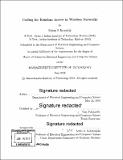Coding for random access in wireless networks
Author(s)
Kowshik, Suhas S.(Suhas Subramanya)
Download1126651007-MIT.pdf (3.176Mb)
Other Contributors
Massachusetts Institute of Technology. Department of Electrical Engineering and Computer Science.
Advisor
Yury Polyanskiy.
Terms of use
Metadata
Show full item recordAbstract
Wireless networks in the near future face a formidable challenge of accommodating a dense set of infrequently communicating devices characterized by small data payloads and strict latency and energy constraints. In such a scenario, providing energy efficient random-access access becomes a challenge. Information theoretic analysis of such systems becomes imperative to understand the gap from optimality of the methods of random-access currently employed. In this thesis we discuss the trade-off between the required energy-per-bit to achieve a target probability of error (per-user) and the number of active users. Previous works in this regard focused on the AWGN channel model. In this thesis we consider the issue of Rayleigh fading. Specifically, we use random coding with a subspace projection based decoder to get finite blocklength bounds from which we arrive at the trade-off. Further we justify the use of our decoder by proving its asymptotic optimality for the channel under consideration. We also show that the required energy-per-bit increases from around 0-2 dB (for AWGN) to around 8-12 dB under fading.
Description
Thesis: S.M., Massachusetts Institute of Technology, Department of Electrical Engineering and Computer Science, 2018 Cataloged from PDF version of thesis. Includes bibliographical references (pages 81-83).
Date issued
2018Department
Massachusetts Institute of Technology. Department of Electrical Engineering and Computer SciencePublisher
Massachusetts Institute of Technology
Keywords
Electrical Engineering and Computer Science.